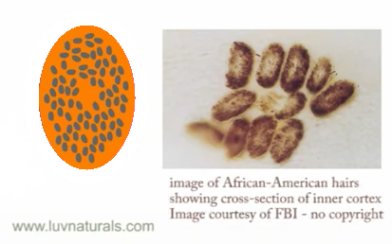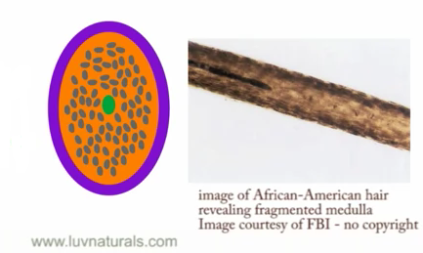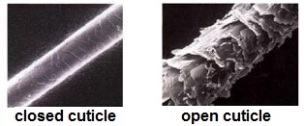In order to learn how to maintain natural hair; one first needs to understand the science behind it. This article is the beginning of a 4 part series of articles that will explain why your hair is often dry and why it is hard to maintain moisture. Using a presentation of facts, this first part will help you understand the basics of the structure of hair. How else are you going to take care of something with no knowledge about it?
Hair is composed of the bulb, root and the shaft. The bulb and the root are found under the scalp. The part that we see is the shaft. Contrary to popular belief, the part of hair that we see, the shaft, is not a living structure. According to biology, once it shoots from the scalp, it is dead. This means that in actuality, there is no such thing as healthy hair because a dead thing cannot be healthy. It is no healthier than your favourite pair of jeans. And, just like your jeans, hair can only be preserved. It is worn and torn from the time it shoots from your head. The image below is a cross section of the hair shaft.
The hair shaft is composed of three layers

source: http://www.luvnaturals.com
1. The Cuticle (Outer layer):

source: http://www.luvnaturals.com
- The cuticle layer, represented as purple, functions as the protective outer layer for the protein inside from outside elements including sun exposure or too much water absorption. It has an overlapping structure like the bark of a tree. Human beings have anywhere between 5 to 10 cuticle layers. Afro textured hair however, has fewer layers (8 to 12) than Asian hair (more than 12), but more than Caucasian hair (4 to 7). Similar to the cuticle found on your finger nails (nails contain the same protein found in our hair), the cuticle is actually colourless and transparent. Apart from protection, the cuticle helps to lock moisture/water in the cortex.
2. The Cortex (Inner layer):
- The cortex, is made up of protein bundles (represented as grey spots). These bundles are held together by “inter-cellular cement” (represented as orange), which is a mix of lipids(fatty acids), water and trace elements of vitamins, metals and other chemicals supplied from our blood (doctors can tell your drug use history using your hair). The cortex makes up most of the hair mass. It gives hair its colour, strength, elasticity and shape/texture. Hair colour comes from a natural pigment called melanin, found in-between the protein strands. The darker hair you have, the more melanin inside. When there is little to no melanin, your hair grows out white and you have what we call grey hair (even though it really is white, it just looks grey because it is a mixture of coloured and white hair). Protein itself has no colour. The cortex layer is where chemical processes such as hair relaxers and colour changes, take place.
3. The Medulla (Centre):
- This is a soft, spongy mass of cells in the most central part of the hair shaft (represented as the green circle). The medulla is not always present throughout the hair shaft; it can be continuous, fragmented or not there at all. While it is not certain what purpose it holds; many researchers believe it has something to do with the regulation of body temperature. Remember that is the purpose of the hair on the body to regulate body temperature by keeping us warm when it is cold and protecting us from the sun.
Now that you understand the basics, I am sure you want to know why your hair is often dry? It all goes back to the cuticle. As the outer layer, the cuticle protects the protein strands inside, locks moisture in and gives your hair its sheen or shine* when the overlapping layers are closed. Remember the cuticle’s overlapping layers?
So to keep your hair moisturised, you must encourage your cuticle to close. BUT HOW?
The next article will explain the different methods used to close cuticles and will focus on one method, which seems to be the most effective and yet least harmful to the hair.
- NB *Healthy and happy shine: Ever wonder why Asian and Caucasian hair gets naturally oily whilst we have to add oils to our hair? This is because follicles (found under the scalp), have what are called sebaceous glands that produce a natural oil called sebum. Afro textured hair, unlike Asian and Caucasian hair, is coiled, curled and easily tangled, making it difficult for the sebum to go all the way along the hair shaft, so we have to add oils to get that desired shine.
Source:
- Syed, A. Dr. (2008) Structure of Hair, [Online], Available: http://www.slideshare.net/dralisyed/1-structureof-hair-euro-july-08 [15 June 2013].
- The Structure of Hair (2010), video, <http://www.youtube.com/watch?v=-i3MC4d-HmY&list=PL5532B6CD987E1D88> [23 June 2013].
- Hair Science (no date) Hair Science, [Online], Available: http://www.hair-science.com/_int/_en/index.aspx?tc=ROOT-HAIR-SCIENCE^HOME-HAIR-SCIENCE&cur=HOME-HAIR-SCIENCE& [23 June 2013].



Pingback: THE SCIENCE OF HAIR – PART THREE (pH Balance: So Effective and Yet So Fragile) | Black Afro Hair
Pingback: THE SCIENCE OF HAIR– PART THREE (pH Balance: So effective and yet So Fragile) | Black Afro Hair
Pingback: Difference between Asian Hair | Natural Hair Care Tips
Cảm ơn . Thank you
Pleasure xoxo
I really enjoyed this. I have a new look on my natural and just hair in general.
Glad you enjoyed this! It helped me a great deal with my natural hair.